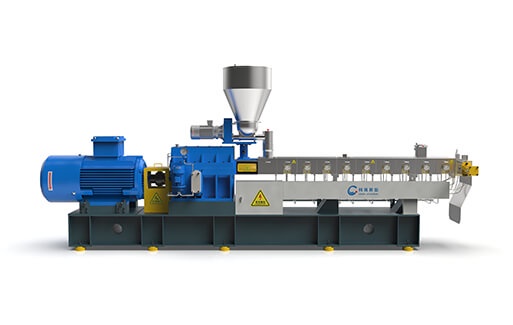The global concern over plastic waste and its environmental impact has led to a growing urgency to find effective recycling solutions. Polyethylene Terephthalate (PET) distinguishes itself among various plastics for its extensive utilization in bottles, containers, and packaging materials. To tackle the challenge of PET plastic waste, the recycling industry has turned to advanced technologies, and one such innovation is the use of Twin Screw Extruders. These remarkable machines are revolutionizing PET plastic recycling by enhancing efficiency, quality, and sustainability.
In this article, we mainly introduces PET(polyethylene terephthalate), PET extrusion process through twin screw extruder, and the advantages of twin screw extruders in processing PET.
The significance of PET recycling
Polyethylene terephthalate (PETE or PET) stands as the world’s most prevalent thermoplastic polymer. In the textile sector, it is recognized under the trade name “polyester.” This naturally transparent and semi-crystalline plastic finds extensive applications as a clothing fiber, an efficient moisture barrier, and in bottling and packaging, often referred to as PET or “PET resin.” Additionally, PET serves as a versatile engineering plastic, capable of enhancing material strength when combined with substances like fiberglass or carbon nanotubes.
Key attributes of PET plastic encompass its exceptional water resistance, impressive strength-to-weight ratio, shatterproof nature, and widespread affordability as an easily recyclable material. PET plastic is an omnipresent presence in our daily routines. Nonetheless, its durability also plays a role in its extended persistence in the environment, underscoring the urgent need for recycling. PET recycling not only alleviates the strain on landfills but also preserves valuable resources while mitigating greenhouse gas emissions linked to the production of fresh PET materials.
How is PET recycled through PET extruder machine?
PET plastic recycling through a PET extruder machine involves a series of steps to transform post-consumer or post-industrial PET waste into usable materials. Following is the process:
- Collection and Sorting: The PET recycling journey begins with the collection of PET plastic waste, which is then meticulously sorted to remove non-PET items and contaminants. This initial step ensures that the subsequent recycling process is more efficient and produces cleaner materials.
- Washing and Cleaning: Thoroughly cleaning the sorted PET plastic is vital for achieving high-quality recycled materials. This stage eliminates any lingering impurities, residues, or labels, setting the foundation for a pristine recycling process.
- Shredding and Size Reduction: PET plastic is transformed into more manageable pieces through shredding and size reduction, typically resulting in flakes or pellets. This size reduction step not only facilitates PET extrusion process but also prepares the PET material for its transformation into a new product.
- Extrusion: The heart of PET recycling, PET extrusion process, involves melting and homogenizing the shredded material within a PET extruder machine. Heat and pressure are gradually applied as the PET material progresses through the machine. This step transforms the waste into a versatile, viscous melt, ready for reshaping.
- Die and Cooling: After extrusion, the molten PET material passes through a die, taking on the desired form, whether it’s pellets, sheets, or profiles. The material is then rapidly cooled to solidify its shape, ensuring that it maintains its integrity and quality.
- Quality Control and Testing: To guarantee that the recycled PET materials meet industry standards and product specifications, quality control tests are conducted. This step ensures that the final product is consistent and reliable, meeting the needs of various industries.
Common PET extrusion machine related to PET plastic recycling
The most common extruder used for PET (Polyethylene Terephthalate) recycling is the Single Screw Extruder. Single screw extruders are widely employed in PET recycling processes due to their simplicity and cost-effectiveness. They are suitable for basic PET recycling applications and can be used to produce recycled PET (rPET) materials that can be used in a variety of products, including bottles, fibers, and packaging materials.
However, for more advanced PET recycling processes that require decontamination, material purification, or precise compounding, twin screw extruders or multi-screw extruders may be preferred due to their enhanced capabilities. In next part, we will introduce the specific advantages of using twin screw extruders as PET recycling extruder.
Apart from single-screw and twin-screw extruders, another extruder sometimes used for PET plastic recycling is the multi-screw Extruder, which can have three or more screws. While multi-screw extruders offer enhanced mixing and compounding capabilities, they are not as common as single and twin-screw extruders due to their higher complexity, cost, and specific suitability for certain applications.
Advantages of using twin screw extruders in PET recycling
In the pursuit of greener and more efficient PET recycling, the utilization of twin screw extruders has become a pivotal strategy, driven by their numerous advantages. Following are the advantages of twin screw extruders in enhancing PET recycling:
Enhanced Mixing Capability:
Utilizing two independent screws, the twin-screw extruder excels at thorough blending and processing materials. This unique design fosters higher mixing efficiency and superior uniformity in material composition. Moreover, it minimizes shear forces within the screws, thereby mitigating material degradation and stratification, ultimately elevating the quality and stability of PET recycling granulation.
Elevated Processing Efficiency:
The dual-screw configuration of the extruder reduces the impact of shear forces on materials, resulting in decreased material degradation and stratification. This not only enhances the efficiency of PET recycling and granulation but also ensures the consistent quality and stability of the output. Additionally, the twin-screw extruder can concurrently process multiple materials, reducing production time and costs while boosting overall efficiency.
Increased Production Output:
Leveraging its two independent screws, the twin-screw extruder minimizes shear forces within the material, effectively curbing degradation and stratification. This optimization contributes to enhanced PET recycling and granulation efficiency, maintaining superior quality and stability. Furthermore, its capability to handle multiple materials simultaneously streamlines production, reducing time and costs, and elevating overall output.
Augmented Operational Stability:
Through the deployment of two independent screws, the twin-screw extruder ensures materials experience reduced shear forces during processing, preventing material degradation and stratification. This, in turn, bolsters the efficiency of PET recycling and granulation while maintaining the highest standards of quality and stability . Concurrently processing multiple materials also reduces production time and expenses, promoting operational stability.
Precision Control:
The twin-screw extruder’s utilization of two independent screws minimizes shear forces within the material, effectively mitigating material degradation and stratification. This heightened control enhances the efficiency of PET recycling and granulation, ensuring consistent quality and stability. Furthermore, its capacity to process multiple materials concurrently reduces production timelines and costs, offering enhanced controllability throughout the production process.
Twin-screw extruders have proven their worth in PET plastic recycling and granulation, offering a range of distinct advantages. These extruders can be categorized into three main types: parallel parallel, counter-parallel, and conical. Among these, the co-rotating parallel twin-screw extruder stands out for its exceptional mixing properties, self-cleaning capabilities, and versatile modular design. This adaptability enables it to seamlessly accommodate various material systems and processing requirements, further enhancing the efficiency and quality of PET recycling and granulation processes.
They boast numerous advantages in PET recycling and granulation, including superior mixing efficiency, reduced material degradation and stratification, heightened production efficiency, and enhanced controllability, all of which contribute to superior quality, stability, and cost-effectiveness in the recycling process.
Conclusion
In conclusion, the integration of Twin screw extruders marks a significant stride forward in the realm of PET plastic recycling. These versatile machines have revolutionized the efficiency, quality, and sustainability of the recycling process. With their exceptional mixing capabilities, reduced material degradation, and increased production efficiency, twin screw extruders have become a cornerstone in the endeavor to create a more sustainable future. Their role in enhancing the quality and stability of PET recycling granulation cannot be overstated. As industries and communities increasingly prioritize environmentally responsible practices, the prominence of twin screw extruders in PET plastic recycling is set to continue its upward trajectory, offering a powerful solution towards a greener and more sustainable world.


No comments yet